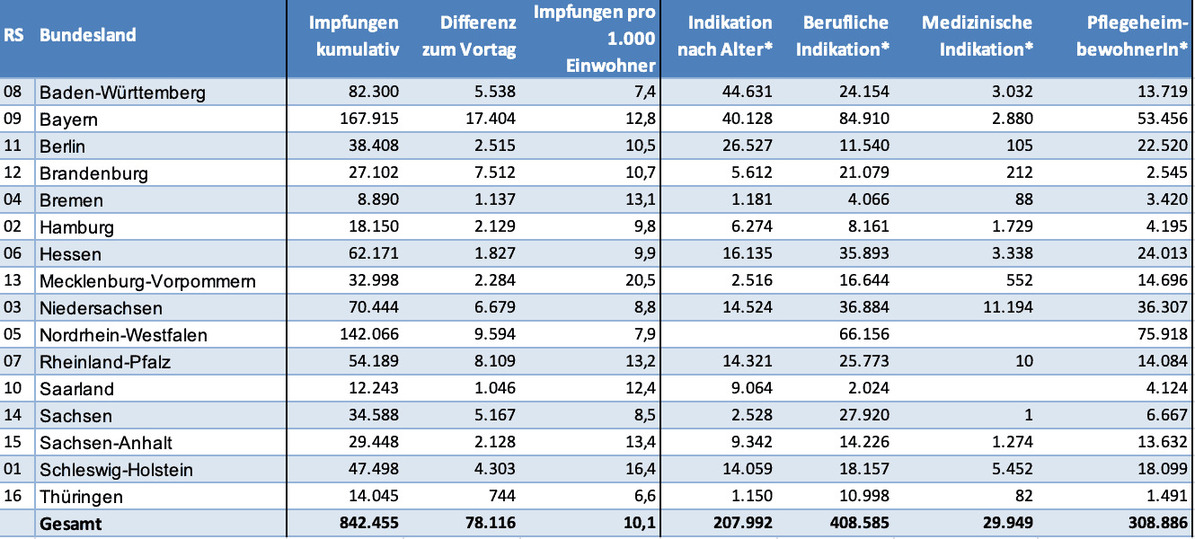According to the Robert Koch Institute (RKI), over the past day in Germany, the number of newly infected people has increased by 22,368, which is less compared to the previous day (26,164)… In addition, the number of deaths increased by 1,113 in the last 24 hours. To date, more than 842,000 people across Germany have been vaccinated against Covid-19.
As of Friday, January 15, 2,000,958 cases of infection have been recorded in the country since the beginning of the collection of official statistical information on the coronavirus. The total number of deaths from Covid-19 to date is 44,994. The R value over 4 days is approximately 0.84. Not all authorities release their data on weekends, so actual numbers may be higher.
The seven-day incidence for Germany is 146.1 This figure shows how many people per 100,000 inhabitants have been infected in the last seven days. The recommended incidence rate is 50, when the infectious situation is considered controlled and all infected can be monitored.
It is estimated that there are approximately 314,900 active cases, that is, people currently infected. This figure is not officially recorded by the Robert Koch Institute. However, as in other countries, it is determined by subtracting the number of deaths (44,994) and the estimated 1,641,200 recovered from all ever infected (2,000,958).
According to the Intensive Care Register, 5,125 people are currently being treated for Covid-19 in intensive care units (as of January 14). This represents approximately 18.98 percent of the approximately 27,000 intensive care beds in Germany.
Since the start of vaccination in Germany, the RKI has published the number of people who have already been vaccinated against Covid-19 every weekday. Currently, 842,455 people have been vaccinated (as of January 14):

A more detailed overview of the situation in individual federal states can be found here:
Baden-Württemberg: there are currently 131.1 registered persons per 100,000 inhabitants. More information here.
Bavaria: morbidity for 7 days 156.0 people per 100,000 inhabitants. More information here.
Berlin: morbidity in 7 days 166.3 people per 100,000 inhabitants. More information here.
Brandenburg: incidence in 7 days 220.2 people per 100,000 inhabitants. More information here.
Bremen: morbidity in 7 days 78.7 people per 100,000 inhabitants. More detailed information can be found here.
Hamburg: morbidity in 7 days 104.4 people per 100,000 inhabitants. More information here.
Hesse: morbidity in 7 days 136.5 people per 100,000 inhabitants. More information here.
Mecklenburg-Western Pomerania: morbidity in 7 days 118.1 people per 100,000 inhabitants. More information here.
Lower Saxony: morbidity in 7 days 93.0 people per 100,000 inhabitants. More information here.
North Rhine-Westphalia: morbidity for 7 days 128.0 people per 100,000 inhabitants. More information is available here.
Rhineland-Palatinate: morbidity for 7 days 118.7 people per 100,000 inhabitants. More information here.
Saar: morbidity in 7 days 139.7 people per 100,000 inhabitants. More information here.
Saxony: morbidity for 7 days is 274.1 people per 100,000 inhabitants. More information here.
Saxony-Anhalt: morbidity in 7 days 243.1 people per 100,000 inhabitants. More information here.
Schleswig-Holstein: currently 90.5 people are recorded per 100,000 inhabitants. More information here.
Thuringia: morbidity in 7 days is 287.6 people per 100,000 inhabitants. More information here.
All important hotlines for health insurance companies, the Robert Koch Institute, as well as lists of medical institutions in all federal states and the best way to protect themselves: you can find out here.
Germany says this:
Germany: In which German banks do you need to pay for keeping money in accounts
Basic pension in Germany: when, for whom and how much
Germany: how to find out within what limits you can move in your area
Germany: in which lands since January 11, there is a measure of limiting the radius of movement